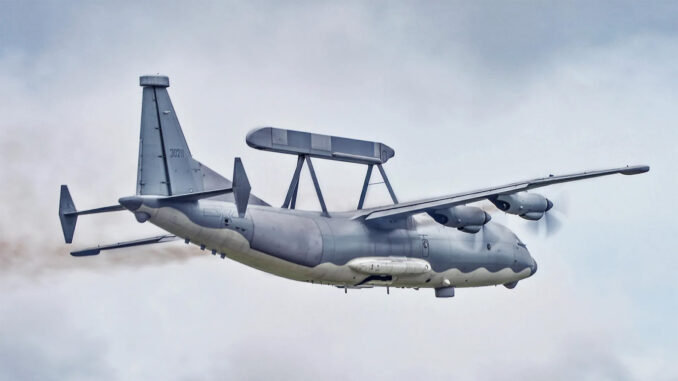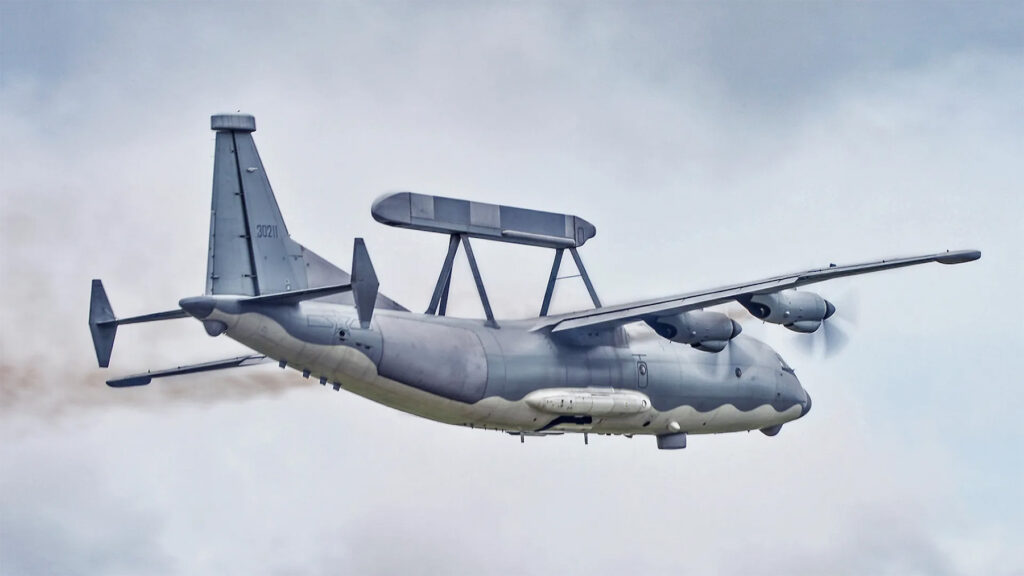
Analysis of the Y-9LG, the Chinese electronic warfare aircraft, its advanced capabilities and its strategic role in modern military operations.
The Y-9LG, a new-generation electronic warfare aircraft developed by China, was recently observed during military exercises in Thailand. This model, based on the Shaanxi Y-9 carrier, is designed to disrupt enemy communications and carry out remote electronic attacks. This platform reinforces China’s ability to dominate the electromagnetic spectrum, a crucial aspect of any modern military operation. With its sophisticated equipment, the Y-9LG could play a central role in future operations in the Asia-Pacific, particularly in the context of potential conflicts involving Taiwan or the United States.
The Y-9LG: a new-generation electronic warfare platform
The Y-9LG is one of China’s latest advances in the field of electronic warfare, an area where domination of the electromagnetic spectrum has become crucial. Developed from the versatile Shaanxi Y-8/Y-9 platform, this model embodies the evolution of China’s electronic disruption capabilities. Rarely seen before, the Y-9LG was recently spotted during Falcon Strike exercises in Thailand, revealing its growing importance to the People’s Liberation Army (PLA).
The Y-9LG is distinguished by its ‘balance beam’ radar antenna mounted above the fuselage. Unlike the KJ-200, a Chinese early warning and control aircraft, the Y-9LG uses this antenna not for detection, but for active jamming of enemy radar signals. By emitting electronically scanned radar beams, it can disrupt the enemy’s communications and command and control systems over long distances. This type of targeted jamming enables the PLA to neutralise multiple targets simultaneously, rendering enemy operations ineffective.
In addition to this jamming capability, the Y-9LG is equipped with various other electronic warfare technologies. A satellite communications antenna is installed on top of the front fuselage, and fairings on the sides of the rear fuselage probably house electronic intelligence (ELINT) or electronic support measures (ESM) antennas. These systems enable the Y-9LG to collect and analyse enemy radio emissions, locate the radars of aircraft, ships or land bases over long distances, and provide critical information for Chinese military operations.
The strategic role of the Y-9LG in Chinese military operations
The Y-9LG is not simply an electronic warfare tool; it plays a central strategic role in the PLA’s military doctrine. Operating from the PLA’s 20th Specialised Division, based in Guiyang-Leizhuang, this model is specifically designed to protect Chinese interests in strategic regions such as the South China Sea and, potentially, in any military operation against Taiwan.
The Y-9LG’s ability to disrupt enemy communications, radar and navigation systems is crucial to the success of PLA operations. In the event of a conflict, the ability to neutralise the enemy’s command and control capabilities could decide the outcome of the fighting. Moreover, by operating at a distance, the Y-9LG minimises the risks to itself while maximising its impact on enemy forces.
Compared with its predecessors such as the Y-8GX-3 and Y-8GX-11, the Y-9LG represents a significant improvement in terms of range and sophistication of jamming equipment. These older aircraft, although still in service, are often deployed near the Taiwan Strait and Japan, demonstrating China’s strategy of projecting electronic power into contested areas. The Y-9LG, with its more advanced capabilities, is therefore a major asset for the PLA as it continues to modernise its forces.

The growing importance of electronic warfare in the current geopolitical context
The emergence of the Y-9LG is taking place against a backdrop of increasing geopolitical rivalry in the Asia-Pacific region, where control of the electromagnetic spectrum is becoming a crucial issue. China, aware of the technological advances of its potential adversaries, is investing massively in electronic warfare platforms capable of countering the sophisticated air defence systems deployed by the United States and its allies in the region.
Electronic warfare, long seen as an adjunct to traditional military operations, is now at the heart of modern military strategies. The Y-9LG’s ability to jam communications, disable radars and disrupt navigation systems makes it a key player in any future conflict in the Asia-Pacific. For example, in a conflict scenario with Taiwan, the Y-9LG could play a decisive role in disabling Taiwanese air defence systems, thus facilitating a possible Chinese offensive.
In addition, the Y-9LG’s ability to operate in complex environments, such as the Spratly Islands in the South China Sea, demonstrates the flexibility and adaptability of this platform. Its autonomy and ability to gather intelligence on distant targets make it an indispensable tool for the planning and execution of Chinese military operations.
Challenges and implications for China’s potential adversaries
While the Y-9LG represents a significant advance for China, it also poses new challenges for its adversaries. The United States, in particular, must take this new capability into account in its strategic planning. Air Force Secretary Frank Kendall has already warned against China’s emphasis on electronic warfare capabilities, underlining the need for the US to strengthen its own electronic defence systems.
The Y-9LG’s ability to operate in stand-off mode raises questions about the survivability of such platforms in a high-intensity conflict. Long-range air defence systems, which are becoming increasingly sophisticated, could theoretically threaten these electronic warfare aircraft. However, China has the geographical advantage of operating close to its own bases, which could offer additional protection.
Finally, the development of the Y-9LG underlines the need for other powers, particularly the United States and its allies, to continue to invest in advanced electronic countermeasures. Electronic warfare is no longer a simple back-up tool; it has become a central element of modern warfare, capable of determining the outcome of conflicts. The rise of Chinese capabilities in this area demands an appropriate strategic response from Western armed forces.
A turning point in electronic warfare?
The Y-9LG represents a turning point in China’s approach to electronic warfare, marking an important stage in the modernisation of its armed forces. By developing a platform capable of effectively disrupting enemy communications and defence systems, China is strengthening its position in the electromagnetic spectrum, an increasingly crucial area for modern military operations.
The implications of this technological advance are far-reaching, not only for China but also for its potential adversaries. As tensions in the Asia-Pacific increase, the ability to dominate the electromagnetic spectrum could well become a decisive factor in future conflicts. The Y-9LG, with its advanced capabilities, is a clear signal that China is ready to meet this challenge.
War Wings Daily is an independant magazine.